The Pancreas: Its Location and Essential Functions
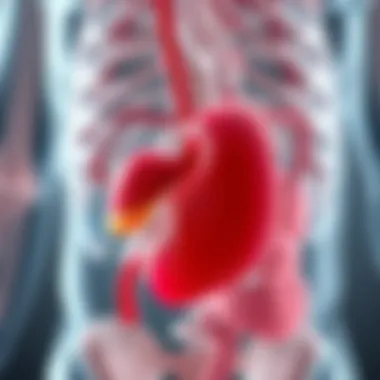
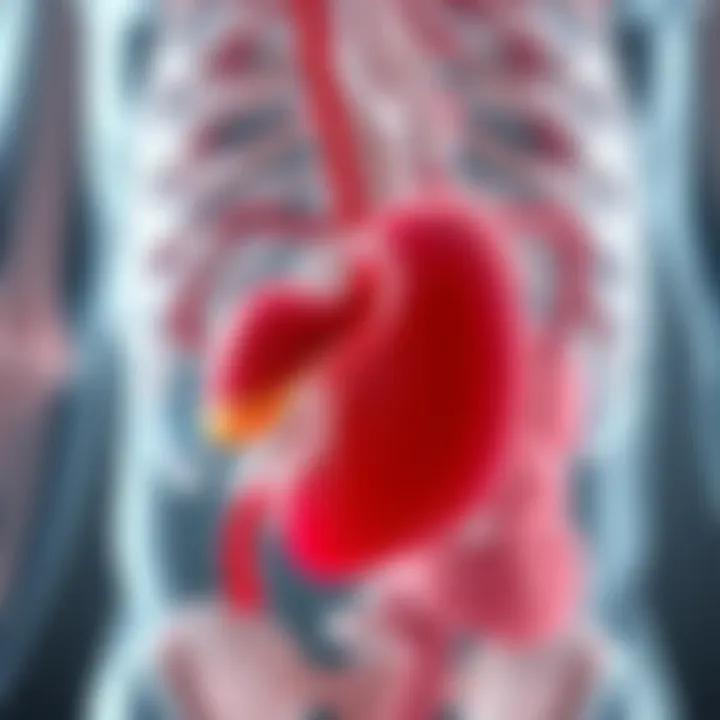
Intro
The pancreas, an elongated organ lying deep within the abdomen, often slips through the cracks of common medical discussion. Shaped a bit like a flattened fish, it’s nestled between the stomach and the spine, sandwiched with a purpose, playing crucial roles in digestion and metabolism. Understanding its juxtaposition with nearby organs—like the liver, small intestine, and spleen—provides insight into how this small but mighty organ upholds the body's well-being. But that’s not all; this article aims to peel back the layers on what the pancreas does and why maintaining its health is essential for overall vitality.
As we navigate through the intricacies of the pancreas's location and functionality, a clear picture will emerge showcasing not just its physical attributes but its vast contributions to bodily processes. An educative journey into the pancreas opens the door to recognizing signs of potential issues, instilling a proactive approach to health and wellness.
Why bother, you might ask? Because knowledge about this organ goes hand-in-hand with making informed choices regarding lifestyle, nutrition, and overall health management.
Key Benefits
The benefits of understanding the pancreas extend beyond anatomical knowledge or academic pursuit. When one comprehends the significant roles this organ plays, it leads to tangible improvements in physical health and mental well-being.
Physical Health Benefits
- Enhanced Digestion: A well-functioning pancreas ensures adequate enzyme production, leading to optimal digestion of nutrients. This not only aids in maintaining energy levels but also in the absorption of vital vitamins and minerals.
- Blood Sugar Regulation: The pancreas is key in regulating insulin production. Understanding it can help individuals manage their blood sugar levels effectively, lowering the risk of conditions such as diabetes.
- Prevention of Digestive Disorders: Gaining insights about pancreatic health helps individuals recognize symptoms of potential disorders, prompting early intervention and management.
Mental Well-being Enhancements
- Reduced Anxiety about Health: Knowledge brings power, and knowing how your pancreas functions can alleviate stress regarding health issues, giving a sense of control.
- Improved Lifestyle Choices: By understanding the link between the pancreas and metabolism, individuals are more inclined to make healthier eating and exercise choices, enhancing mood and mental clarity.
"Awareness of our body's functions can guide us toward healthier decisions, paving the way to a promising future."
Equipped with this knowledge of benefits, readers can navigate practical approaches to maintaining pancreatic health, influencing not just longevity but a richer quality of life.
Practical Tips
To harness the benefits discussed, implementing practical strategies in daily life becomes central. Here’s a closer look at steps one can take to support pancreatic health.
Effective Meal Planning
- Balanced Diet: Focus on whole foods rich in vitamins. Include leafy greens, lean proteins, and healthy fats to ensure a comprehensive nutrient intake.
- Portion Control: Regularly consuming smaller portions can relieve stress on the digestive system, giving the pancreas room to function optimally.
Quick and Efficient Workouts
- Regular Cardio: Aim for at least 30 minutes of moderate cardio several times a week. Activities could be as simple as brisk walking or cycling.
- Strength Training: Incorporate strength training a few times a week to boost metabolism and support overall health.
By implementing these strategies, individuals not only bolster pancreatic health but also enrich their overall well-being. This dual focus on understanding and action can be the compass guiding caregivers, health professionals, and wellness enthusiasts alike toward fostering an environment conducive to health.
The Anatomy of the Pancreas
Understanding the anatomy of the pancreas serves as the bedrock of comprehending its multifaceted role in the human body. The pancreas, an olive-shaped gland, can be likened to a vital cog in the wheel of digestion and metabolic regulation. Its significance cannot be understated as it intervenes critically in processes that are essential for sustaining life and health. By exploring the anatomical layout and relationships of the pancreas, we gather insights into its impact on health and disease, and this serves as a solid foundation for anyone from health professionals to wellness enthusiasts.
Definition and Role of the Pancreas
The pancreas is a unique organ that straddles the line between an endocrine and exocrine gland. That’s like having two hats to wear. On one hand, it produces hormones such as insulin and glucagon, which are integral to controlling blood sugar levels. On the other, it secretes digestive enzymes—amylase, lipase, and proteases—that aid in breaking down carbohydrates, fats, and proteins in the small intestine. This dual role underscores the pancreas as a central player in both digestion and metabolic homeostasis, making its proper functioning a cornerstone for overall health.
Location of the Pancreas in the Body
The pancreas is nestled deeply within the abdominal cavity, making its exact location not as straightforward as one might expect. Understanding where it resides in relation to other organs can provide clarity on incidences of pain or discomfort and helps illuminate its role in various health conditions.
Relative position to major organs
The pancreas is strategically located behind the stomach, snuggled in close proximity to the duodenum, the first segment of the small intestine. This unique position not only facilitates the direct release of digestive enzymes but also emphasizes its connection to vital organs; for instance, it lies near the spleen and kidneys. This close-knit arrangement means that issues arising in one organ may very well impact the others. The pancreas acts as a bridge, helping harmonize the intricate relationships among digestive processes and metabolic functions. This is invaluable when considering how diseases like pancreatitis can affect adjacent organs, illustrating the critical interplay within the abdominal ecosystem.
Orientation within the abdominal cavity
Position-wise, the pancreas is oriented horizontally with its head nestled in the curve of the duodenum. The body stretches toward the left side of the abdomen, terminating as the tail which extends near the spleen. This orientation affects not only the way the pancreas interacts with adjoining organs but also how imaging and surgical interventions are approached. Its horizontal stance is significant in surgical procedures and imaging diagnostics, where understanding its alignment can greatly influence outcomes. This nuanced positioning is crucial, as unexpected complications might arise due to undesirable proximity to major vessels and nerves.
Imaging techniques for locating the pancreas
To visualize the pancreas, clinicians rely on various imaging techniques, each possessing distinct advantages. Ultrasound, for instance, is a safe, non-invasive method often used as a first-line imaging tool. However, it can be limited in visualizing deeper structures, such as the tail of the pancreas. CT scans provide a more comprehensive view and are excellent for assessing structural abnormalities. They can highlight tumors or inflammation in greater detail, aiding in accurate diagnosis and treatment planning. Finally, MRI might be employed for specific cases, especially when soft tissue contrast is needed. Here's the kicker: understanding how to appropriately utilize these imaging modalities can be the difference between catching a condition early or letting it fester unnoticed.
"The location and function of the pancreas are intertwined in a dance that speaks to the complexity of human physiology. Knowing its tricks unveils the secret to a healthy life."
From its anatomical position to the relationship with surrounding organs, the pancreas stands at a crossroads of digestive and endocrine functions, illustrating its importance and the need for careful attention in both health and disease.
Structure of the Pancreas
The structure of the pancreas plays a critical role in its function and overall significance in the body. Uncovering the intricate design of this gland not only offers insights into its multiple roles in digestion and metabolism but also enhances the understanding of various health conditions tied to pancreatic dysfunction. The pancreas is unique in that it contains both exocrine and endocrine tissues, contributing substantially to both digestive processes and metabolic regulation. Understanding each anatomical division is essential for appreciating how this organ influences bodily health.
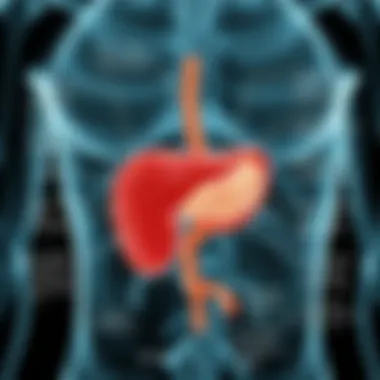
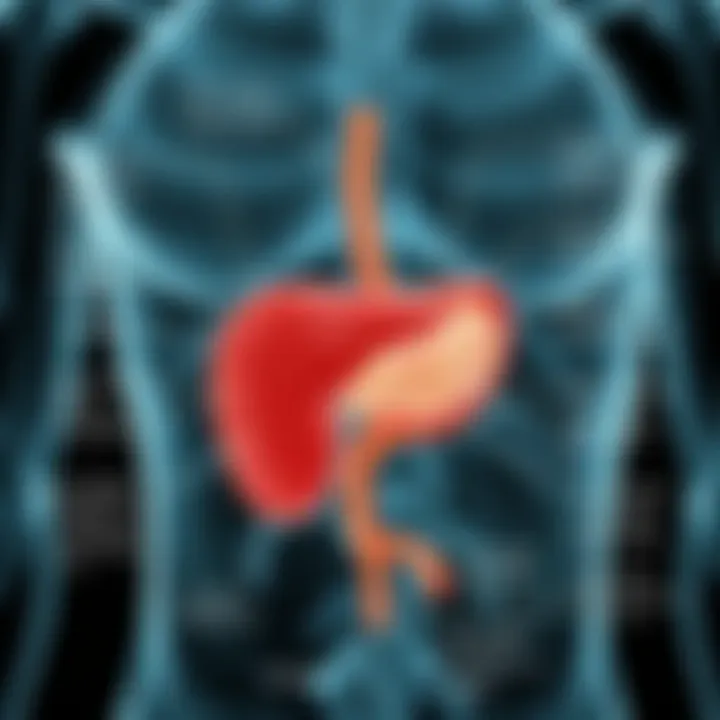
Anatomical Divisions of the Pancreas
Head
The head of the pancreas is located on the right side of the abdomen, adjacent to the duodenum, the first part of the small intestine. This positioning means the head plays a pivotal role in the initial stages of digestion. The key characteristic of the head is its close proximity to the ducts that release digestive enzymes directly into the digestive tract. This feature makes the head highly significant for digestive efficiency. A unique aspect of the head is its relationship with the common bile duct, where bile from the liver and enzymes from the pancreas can mix. This connection aids in the emulsification of fats, showcasing a clear advantage in effective digestion. However, disorders such as pancreatitis can significantly impact this portion, leading to a cascade of digestive issues.
Body
The body of the pancreas is approximately in the middle section of the organ, positioned between the head and the tail. It acts as the main part responsible for the bulk of pancreatic enzyme production. A key characteristic of the body is its size and its internal structure, filled with acinar cells that produce important digestive enzymes like amylase and lipase. This aspect makes it crucial for breaking down carbohydrates and fats. Additionally, the body contains pancreatic islets which are involved in hormonal secretions. However, the body's vulnerability to conditions like diabetes can have widespread implications, especially since the production of hormones like insulin occurs here.
Tail
The tail of the pancreas is the narrowest section, extending to the left side of the abdomen. Its position makes it unique, as it is in close proximity to the spleen. The key characteristic of the tail is how it houses a different concentration of the hormonal islets, making it important for insulin and glucagon production. This feature underscores its role in blood sugar regulation, which is often overlooked. However, the disadvantage of this region is its tendency to be affected by tumors, especially in the context of pancreatic cancer, making it crucial to screen and monitor this area closely.
Histological Composition
Understanding the histological composition of the pancreas provides further insight into how it really works at a microscopic level. The pancreas is composed of both exocrine tissues, which help in digestion, and endocrine tissues, which regulate metabolism. This duality is significant as it highlights the complex interplay between digestion and metabolic control, reflecting the organ's versatile nature.
Exocrine tissues and their function
Exocrine tissues predominantly comprise acinar cells that synthesize digestive enzymes. These enzymes are crucial for breaking down food components in the gastrointestinal tract. A beneficial aspect of these tissues is their ability to respond rapidly to food intake by producing the necessary enzymes for digestion, aiding the body in nutrient absorption. An important feature is their secretion pathways, which lead directly into the small intestine via the pancreatic duct. This system ensures enzymes are delivered promptly for effective digestion where and when needed, highlighting a clear advantage in digestive efficiency.
Endocrine tissues and their function
Endocrine tissues consist of the clusters of cells known as the islets of Langerhans. These cells have the critical job of producing hormones such as insulin and glucagon, which are essential for maintaining blood glucose levels. A key characteristic of these tissues is their capacity for rapid hormonal response to changes in blood sugar levels, making them fundamental to metabolic homeostasis. The unique feature of these cells is how they communicate with the bloodstream to exert immediate effects on various organs, underscoring their significance in energy management and overall metabolic health.
"The pancreas is a vital organ that sits quietly on the sidelines, playing a crucial yet oft-overlooked role in digestion and metabolism."
Understanding the structural layout and intended functions of the pancreas helps health professionals tailor their approaches to conditions that affect this critical organ. The nuanced interplay between its parts enhances the understanding of how lifestyle choices can impact its function and ultimately, overall health. By grasping the anatomy and histological composition, one can appreciate the complex nature of the pancreas and the importance of maintaining its health.
Functions of the Pancreas
The pancreas plays a critical role in maintaining bodily functions, acting as a linchpin in both digestion and the regulation of glucose levels. Its contributions stretch beyond mere digestion, influencing metabolic processes that are essential for overall health. Understanding the functions of the pancreas is vital, especially for health professionals and holistic practitioners, as it provides insight into how to manage and optimize pancreatic health. This section will delve into the distinct digestive and endocrine functions of the pancreas, employing detailed analysis and breaking down complex processes into comprehensible elements.
Digestive Functions
The digestive functions of the pancreas are paramount in breaking down and absorbing nutrients from food. These functions stem from its secretory capacity, which releases enzymes crucial for digestion.
Production of digestive enzymes
The pancreas is responsible for producing several vital digestive enzymes, including amylase, lipase, and proteases. These enzymes act as catalysts, speeding up the breakdown of carbohydrates, fats, and proteins, respectively. A noteworthy characteristic of these enzymes is that they are secreted in their inactive forms to prevent the pancreas from digesting itself, thereby ensuring safety. When food enters the small intestine, these enzymes are activated, allowing for efficient nutrient absorption.
The unique feature of these digestive enzymes is their ability to function optimally at specific pH levels, typically within the alkaline environment of the small intestine. This characteristic yields significant advantages in nutrient absorption; without these enzymes, the body would struggle to glean essential nutrients from food, potentially leading to malnutrition and other health issues.
However, there are disadvantages too. Dysfunction in enzyme production can lead to conditions like exocrine pancreatic insufficiency, wherein the body does not produce enough enzymes, making digestion incomplete and nutrient absorption challenging.
Role in carbohydrate and fat digestion
When it comes to carbohydrates and fats, the pancreas is crucial for facilitating their breakdown into absorbable units. The role in carbohydrate digestion is particularly significant. When carbohydrates enter the digestive system, amylase begins the breakdown process by converting starches into simpler sugars, allowing for quicker assimilation into the bloodstream. The ability to efficiently transform carbohydrates is essential in maintaining stable blood glucose levels, crucial for overall energy management.
On the fatty front, lipase is the enzyme tasked with digesting fats. This is vital for not just energy production but also for the absorption of fat-soluble vitamins, which support various bodily functions ranging from vision to bone health.
While the pancreas excel in these areas, its dependency on a fully functional digestive system raises challenges. Any obstruction or lesions can hinder enzyme secretion. As such, issues like pancreatitis can greatly compromise fat and carbohydrate digestion, leading to malabsorption and significant weight loss, emphasizing the need for careful management of pancreatic health.
Endocrine Functions
Beyond its digestive prowess, the pancreas serves a critical role in regulating blood sugar levels through its endocrine functions. It acts like a tightrope walker, balancing the intricate act of supplying insulin and glucagon to the bloodstream.
Insulin production
Insulin is perhaps the most recognized hormone produced by the pancreas. This hormone is essential for controlling blood glucose levels, allowing cells to uptake glucose for energy and storing excess sugar as glycogen in the liver and muscles. The key characteristic of insulin is its ability to prompt the uptake of glucose, lowering the blood sugar levels when they spike after meals.
The unique feature of insulin production lies within the islets of Langerhans, specialized cells in the pancreas responsible for this hormone's secretion. Proper insulin regulation is enormously beneficial; it protects against conditions like hyperglycemia and diabetes. Yet, imbalances in insulin production can lead to diabetes mellitus, a chronic condition that significantly impairs quality of life and requires stringent management.
Glucagon regulation
In contrast to insulin, glucagon serves the opposite role in terms of blood sugar regulation. It raises blood glucose levels when they drop too low, signaling the liver to release stored glucose. This delicate balance between insulin and glucagon is crucial for metabolic homeostasis, making glucagon regulation a vital aspect of pancreatic function.
The unique aspect of glucagon production is its response to low blood sugar levels. In emergencies, it acts as a rapid counterbalance, protecting the body from dangerously low glucose levels, a condition known as hypoglycemia. The interplay between these two hormones emphasizes the pancreas's role as a stabilizer in energy management, underscoring why its health is pivotal, especially for individuals with metabolic disorders.
Understanding the multi-faceted functions of the pancreas not only elevates our comprehension of human physiology but serves to highlight the significance of maintaining an optimally functioning pancreas for overall health.


"The pancreas is an unsung hero in the intricate saga of our nutritional journey, often overlooked but crucial in playing its part in metabolic harmony."
For further reading on pancreatic functions, consider visiting Wikipedia: Pancreas and Britannica: Pancreatic Function.
Understanding and addressing the roles of both digestive and endocrine functions can pave the way for better health practices and targeted interventions in pancreatic health.
Health Implications of the Pancreas
The pancreas, often overlooked in discussions about human health, plays a pivotal role in maintaining metabolic balance. Understanding its health implications is not just beneficial—it’s essential. In essence, the pancreas contributes to digestion and regulates blood sugar levels, making its health directly linked to overall well-being. Poor pancreatic health can lead to significant disorders that affect various bodily systems, hence highlighting the importance of recognizing and nurturing this organ.
Common Disorders Affecting the Pancreas
Pancreatitis
Pancreatitis is an inflammation of the pancreas that can either be acute or chronic. Acute pancreatitis can strike suddenly, often triggered by gallstones or excessive alcohol consumption, and the pain associated with it can be intense. Chronic pancreatitis, on the other hand, develops over time, often leading to permanent damage. This condition makes it difficult for the pancreas to function correctly. Key characteristics include severe abdominal pain and digestive issues.
This condition is significant to the article because it illustrates the delicate balance the pancreas must maintain. Unique features of pancreatitis, especially its association with lifestyle choices like alcohol consumption, demonstrate the potential for prevention through lifestyle modification. A deeper connection might be made by discussing dietary habits to reduce flare-ups, which can serve as a guide for readers.
Diabetes mellitus
Diabetes mellitus, particularly Type 2 diabetes, stems from the body’s ineffective use of insulin produced by the pancreas. Type 1 results from an autoimmune attack on pancreatic cells. The key characteristic here is blood sugar regulation, or the lack thereof in diabetic individuals. This disorder encapsulates the term 'metabolic disease,' making it crucial for a health-related article.
Discussing diabetes offers a chance to examine the preventative measures that can be employed through lifestyle changes. A unique feature of diabetes management often involves nutrition education, emphasizing how certain foods can stabilize blood glucose levels. This aspect has enormous implications for overall health, as glucose levels affect energy, mood, and long-term health outcomes.
Pancreatic cancer
Pancreatic cancer is one of the most formidable adversaries in oncology, characterized by its typically late diagnosis and poor prognosis. This cancer's key characteristic is its stealth nature; it often shows minimal symptoms until it is advanced.
Addressing pancreatic cancer brings to light the critical nature of early detection and the role genetics may play in one's risk. The unique feature of this type of cancer lies in its resistance to treatment, underscoring the need for ongoing research and education around its symptoms and risk factors. Furthermore, exploring the risk factors would enrich understanding and emphasize the importance of health screenings and awareness.
Lifestyle Factors Impacting Pancreatic Health
Dietary influences
Nutrition plays a monumental role in pancreatic health. A diet high in processed foods and saturated fats can negatively influence pancreatic function, leading to disorders like pancreatitis or diabetes. The key characteristic of this discussion is the emphasis on a balanced diet, loaded with nutrients from fruits, vegetables, and whole grains.
Focusing on dietary influences offers the opportunity to outline specific foods that can enhance pancreatic health while discussing what to avoid. Highlighting this information not only builds awareness but empowers individuals to make informed dietary choices that contribute to their overall health.
Exercise and its effects
Regular exercise is not just a recommendation; it’s a necessity for maintaining pancreatic health. Improved insulin sensitivity and better weight management can be achieved through physical activity. **The key characteristic of exercise relates to the body’s improved ability to regulate blood sugar levels.
Delving into the effects of exercise on pancreatic function allows for exploration of various physical activities suitable for various individuals. Emphasizing the importance of regular exercise creates a natural link between physical health and pancreatic well-being, promoting overall wellness.
Alcohol consumption
Alcohol consumption bears significant implications for pancreatic health. Chronic excessive drinking can lead to pancreatitis and enhance the risk of pancreatic cancer. The key characteristic here would be the duality of moderation versus excess, and the potential for both enjoyment and harm.
It's crucial to explore how the amount and frequency of alcohol intake can influence pancreatic conditions. This discussion allows for an examination of not only personal choices but societal norms around drinking. Considering both angles promotes a more comprehensive understanding of the issue, allowing readers to evaluate their habits critically.
Maintaining a healthy pancreas shapes not only digestive health but also influences metabolic efficiency and overall vitality.
Diagnostic Techniques Related to the Pancreas
The accuracy of diagnosing pancreatic conditions is crucial for effective management and treatment. Various diagnostic techniques offer health professionals the ability to assess the pancreas's health and function. This article will explore the most common methods used, weighing their benefits and considerations.
Imaging Studies
Imaging studies are essential in visualizing the pancreas and detecting any abnormalities. They provide insight into structural issues and help establish baselines for further diagnostics.
Ultrasound
Ultrasound is a non-invasive imaging method using sound waves to create images of internal organs. One significant advantage of ultrasound is its broad availability and ease of use in clinical settings. Its primary role in examining the pancreas is to evaluate its size and identify any external masses or cysts.
A key characteristic of ultrasound is its ability to visualize various abdominal organs without radiation exposure, making it a safe choice for individuals, including pregnant women.
However, the limitations of ultrasound include difficulties in imaging due to gas in the bowel or an obese patient's body habitus, which can obscure clear views of the pancreas. Nevertheless, it remains a popular first-line imaging technique when pancreatic issues are suspected.
CT and MRI scans
Both CT (Computed Tomography) and MRI (Magnetic Resonance Imaging) scans offer more detailed images of the pancreas than ultrasound. CT scans utilize X-rays to create cross-sectional images, while MRI uses magnetic fields and radio waves for its images. These techniques can identify tumors, structural changes, and even inflammation in greater detail.
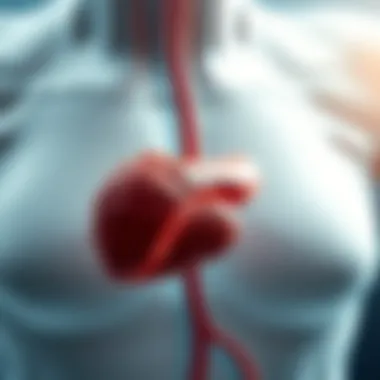
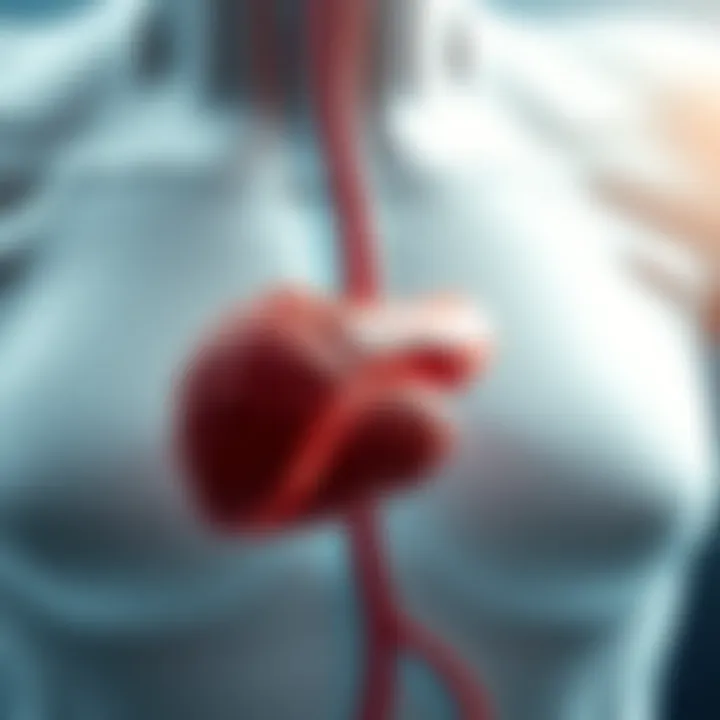
CT scans are particularly beneficial due to their speed and availability, making them suitable for emergencies, where quick assessment is essential. They can also demonstrate the relationship between pancreatic tumors and surrounding blood vessels, which is crucial for surgical planning.
However, the exposure to ionizing radiation in CT scans raises concerns and limits usage in certain populations. MRI, while devoid of radiation concern, often requires longer imaging times, which can be challenging in critically ill patients. Nonetheless, the detailed images produced by CT and MRI scans are invaluable in assessing pancreatic conditions.
Blood Tests
Blood testing is another critical method for assessing pancreatic health. These tests measure levels of certain enzymes and glucose, offering insights into the gland's function and overall health.
Enzyme levels
Enzyme levels, particularly amylase and lipase, are crucial markers used to diagnose pancreatic conditions such as pancreatitis. Elevated levels of these enzymes can indicate inflammation or damage to the pancreas.
A great characteristic of enzyme tests is their rapid feedback to healthcare providers, allowing for quick response to acute conditions. However, interpreting these levels requires careful consideration, as elevations can also occur in other gastrointestinal disturbances.
Glucose testing
Glucose testing measures the body’s blood sugar levels, which can be significantly impacted by pancreatic function. Since insulin production occurs in the pancreas, abnormalities in glucose levels can indicate dysfunction in this gland.
This test is beneficial in diagnosing diabetes mellitus, a condition closely tied to pancreatic health. Furthermore, it can help monitor diabetes management over time. However, glucose levels alone do not provide a full picture and should often be considered alongside other tests to diagnose underlying issues effectively.
Blood tests like enzyme levels and glucose testing provide an immediate window into pancreatic health, making them indispensable in diagnostic protocols.
Maintaining Pancreatic Health
Maintaining pancreatic health is essential for overall well-being. The pancreas is not just a silent player behind the scenes; rather, it has multiple roles that profoundly affect everything from digestion to blood sugar regulation. When the pancreas is functioning optimally, it allows the body to manage nutrients effectively and maintain stable glucose levels. However, a host of lifestyle factors can strain this impressive organ, leading to potential disorders. Thus, understanding the ways to maintain pancreatic health becomes crucial for individuals looking to enhance their quality of life.
Nutrition for a Healthy Pancreas
Balanced diet guidelines
A balanced diet is like the backbone of good health. It's fundamental for nurturing every part of your body, including the pancreas. When we speak about balanced diets, we're primarily talking about consuming the right proportions of carbohydrates, proteins, and fats, along with vitamins and minerals. The harmony of these elements plays a pivotal role in ensuring the pancreas gets the support it requires to perform its functions smoothly. A diet that leans heavily on processed foods tends to place an extra burden on the pancreas, often leading to inflammation or dysfunction.
Key characteristics of balanced diet guidelines include variety and moderation. It is a beneficial choice for maintaining pancreatic health because it encourages individuals to explore a wide range of foods. The unique feature of balanced diets is their flexibility, allowing people to adapt these guidelines to their cultural preferences and tastes without sacrificing nutritional value. However, the challenge remains that it requires individuals to be proactive in learning about food choices and their impacts. It is not just about eating less sugar or fat; it's about a comprehensive approach to food.
Foods to support pancreatic function
Incorporating specific foods into one's diet can significantly support pancreatic function. Focused foods, like leafy greens, lean proteins, whole grains, and healthy fats can all contribute positively to pancreatic health. They are often rich in antioxidants and nutrients that combat oxidative stress within the organ. A notable characteristic of these foods is how they help reduce inflammation, a significant factor in many pancreatic disorders.
These supportive foods often become a popular topic among health professionals due to their potential benefits. The unique feature of such foods is their ability to offer protective effects while also being deliciously versatile in various cuisines. Although the downside is that some may find it challenging to break habits of consuming high-sugar or high-fat foods, adopting a diet rich in these pancreatic-supportive foods can lead to improved overall health and vitality.
Exercise Regimens to Support Pancreatic Health
Recommended physical activities
Regular physical activity is another cornerstone of maintaining pancreatic health. Whether it's taking a brisk walk, cycling, or engaging in strength training, these activities can help regulate blood sugar levels and improve insulin sensitivity. The key characteristic of recommended physical activities is their wide inclusivity; almost anyone can find a form of exercise that suits their ability and preference.
This aspect makes physical activity an excellent choice for many seeking to bolster their pancreatic health. The unique feature of these activities is that they can have immediate effects on glucose metabolism, showing how quickly the body can respond to physical movement. However, some individuals may face barriers, such as lack of motivation or existing health issues, making it essential to offer tailored solutions to encourage participation in such exercises.
Importance of regular exercise
Regular exercise carries profound importance for maintaining pancreatic health and overall metabolic condition. When the body engages in consistent physical activity, it improves the way it processes glucose, thereby reducing the likelihood of insulin resistance and potential diabetes. One can't overlook the power of regular exercise in establishing a healthy lifestyle; it's a fundamental building block.
The key characteristic of establishing a routine of physical activity is that it often leads to compounded benefits over time—not just for the pancreas, but for overall health. The unique feature of this consistency is how it cultivates discipline and embeds a positive health perspective into individuals' lives. Yet, sometimes, one might struggle with integrating this into their daily routine. Acknowledging these challenges means finding achievable ways to incorporate more movement throughout the day, rather than adopting an all-or-nothing mentality.
Regular engagement in exercise and healthy eating not only protects the pancreas but supports your entire body, transforming your approach to health.
In summary, embracing nutritional and physical activity practices can significantly enhance pancreatic health. It underscores the intricate relationships between diet, exercise, and the myriad ways the pancreas contributes to essential bodily functions. Through a concerted effort, individuals can often prevent issues before they arise, ensuring a healthier life.
Finale
The importance of a thorough understanding of the pancreas cannot be overstated. This organ, though relatively small compared to others, plays a monumental role in our digestive and metabolic processes. A conclusion serves as a vital summary, weaving together the various threads discussed throughout the article, emphasizing the significance of each aspect—from anatomical positions to the diverse functions it performs.
Summary of Key Points
In summarizing the key elements, the pancreas is situated in the abdomen, nestled between the stomach and the spine, making its location crucial for its functions. We explored how its anatomical divisions—the head, body, and tail—affect its roles in digestion and hormone production. Furthermore, the distinction between the exocrine and endocrine systems was highlighted.
To put it simply, the exocrine part of the pancreas produces digestive enzymes that break down food, while the endocrine part regulates blood sugar levels through insulin and glucagon. This twofold function underlines the complexity of the pancreas and its indispensable contributions to health.
- The pancreas is a key player in digestive health.
- It regulates glucose levels as part of the endocrine system.
- Disorders of the pancreas can have dire implications for overall wellbeing.
Final Thoughts on Pancreatic Health
Looking ahead, it’s imperative that we recognize the lifestyle choices that nurture pancreatic health. Proper nutrition, regular exercise, and moderation in alcohol consumption are essential. For anyone invested in health—be it professionals like wellness coaches or nutritionists—the insights gleaned from understanding the pancreas can vastly improve approaches to holistic health.
"An ounce of prevention is worth a pound of cure." Staying informed about pancreatic health is a proactive measure that sustains not just individual health but also collective wellbeing. Maintaining a balanced diet rich in antioxidants and fiber, combined with regular physical activity, can play a pivotal role in preventing pancreatic disorders.
By consolidating this knowledge, health practices can be refined, ultimately leading to healthier populations. It's about creating awareness that the pancreas deserves our attention as much as other vital organs. Let's continue to prioritize this overlooked powerhouse in our discussions and practices.













